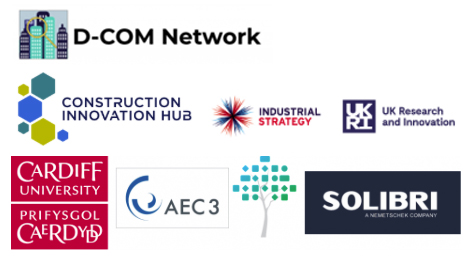Approved Documents compliance process digitalised
Contents |
[edit] A demonstration project
A demonstration project has successfully digitalised the Approved Documents compliance process.
The D-COM demonstrator project (a partnership between the Construction Innovation Hub and Cardiff University's Digital Compliance Network) has enabled the digitalisation of Approved Documents, so they are machine-readable and easier to compare against building and product information.
Also involved in D-COM were: international BIM consultancy AEC3 UK; construction software giant Solibri UK; and innovation management specialist Process Innovation Factory.
D-COM is supported by a digital ecosystem that integrates the tools and data sources that firms must use as part of the compliance process, making information more accessible and, the Hub hopes, driving greater and more consistent levels of compliance.
[edit] Real-world BIM models
D-COM's technology was run against real-world 3D BIM models in Solibri's system for the proof of concept. D-COM interprets the approved document, works out what requirements are relevant to a project, and then interfaces with Solibri (and other similar systems) to ask for feedback. Thus, a project team can get an early view of compliance failures before going to building control without much human input.
Also included are tools that create audit trails of compliance checks, which will help in fulfilling requirements for golden threads for buildings.
Dr Thomas Breach, reader at Cardiff University and D-COM Network leader, explained: "The successful development and demonstration of our prototype demonstrates the power of machine-readable construction guidance. This includes the ability to visualise and interrogate changes between document versions, as well as searching and drawing together all clauses focused on key concepts across the different documents that make up the UK construction regulatory landscape.
"This project has shown that semi-automated checking of building designs is feasible now and that its feasibility will grow as information management adoption increases."
[edit] Integrating compliance checking tools
He added: "Furthermore, it has shown that there is a large number of high-quality tools that assist in the compliance checking process already available – what is needed is the ability to integrate these tools. This is a task that the prototype developed in the project is able to do well, integrating the text of Approved Documents, high-level decision making and technical compliance checking tools, to provide a complete compliance checking solution."
Dr Ahmed Alnagger, the Hub's digital construction lead, said: "Creating that confident relationship between our buildings, linear infrastructure and trust of those who use them is essential. This connection needs a clear line-of-sight between our built assets and compliance with regulatory frameworks."
Those involved in D-COM are keen to find organisations keen to take the technology to the next stage.
The D-COM project sits alongside other projects the Hub is completing around quality assurance processes and building product information. This includes LEXiCON, which will drive the creation of standardised construction product templates. This supports the goals of D-COM by making product information easier to compare against approved documents.
This article first appearer on the CIAT news website on July 18 and is cross-referenced as having also appeared on BIM+
--CIAT
[edit] Related articles on Designing Buildings
- Approved documents.
- Approved inspector.
- Building control body.
- Building control performance standards.
- Building regulations inspection.
- BIM maturity levels.
- BIM resources.
- Construction Operations Building Information Exchange (COBie).
- Common data environment.
- Digital information.
- Digital model.
- LEXiCON
- Simplified Building Energy Model.
Featured articles and news
Lighting Industry endorses Blueprint for Electrification
The Lighting Industry Association fully supports the ECA Blueprint as a timely, urgent call to action.
BSRIA Sentinel Clerk of Works Training Case Study
Strengthening expertise to enhance service delivery with integrated cutting-edge industry knowledge.
Impact report from the Supply Chain Sustainability School
Free sustainability skills, training and support delivered to thousands of UK companies to help cut carbon.
The Building Safety Forum at the Installershow 2025
With speakers confirmed for 24 June as part of Building Safety Week.
The UK’s largest air pollution campaign.
Future Homes Standard, now includes solar, but what else?
Will the new standard, due to in the Autumn, go far enough in terms of performance ?
BSRIA Briefing: Cleaner Air, Better tomorrow
A look back at issues relating to inside and outside air quality, discussed during the BSRIA briefing in 2023.
Restoring Abbotsford's hothouse
Bringing the writer Walter Scott's garden to life.
Reflections on the spending review with CIAT.
Retired firefighter cycles world to raise Grenfell funds
Leaving on 14 June 2025 Stephen will raise money for youth and schools through the Grenfell Foundation.
Key points for construction at a glance with industry reactions.
Functionality, visibility and sustainability
The simpler approach to specification.
Architects, architecture, buildings, and inspiration in film
The close ties between makers and the movies, with our long list of suggested viewing.
SELECT three-point plan for action issued to MSPs
Call for Scottish regulation, green skills and recognition of electrotechnical industry as part of a manifesto for Scottish Parliamentary elections.
UCEM becomes the University of the Built Environment
Major milestone in its 106-year history, follows recent merger with London School of Architecture (LSE).
Professional practical experience for Architects in training
The long process to transform the nature of education and professional practical experience in the Architecture profession following recent reports.
A people-first approach to retrofit
Moving away from the destructive paradigm of fabric-first.
New guide for clients launched at Houses of Parliament
'There has never been a more important time for clients to step up and ...ask the right questions'
The impact of recycled slate tiles
Innovation across the decades.
EPC changes for existing buildings
Changes and their context as the new RdSAP methodology comes into use from 15 June.



























